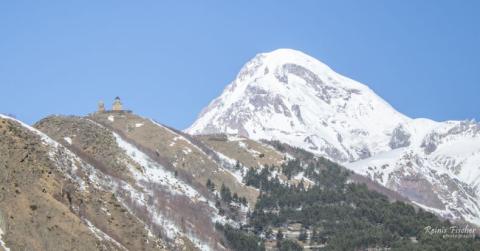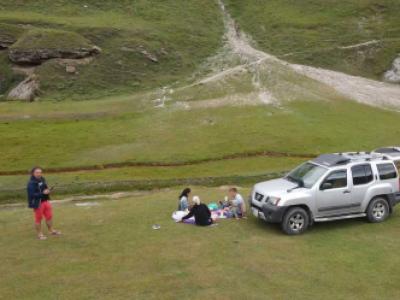Mount Kazbek, is a dormant stratovolcano and one of the major mountains of the Caucasus located on the border of Georgia's Kazbegi District and Russia's Republic of North Ossetia–Alania.
It is the third-highest peak in Georgia (after Mount Shkhara and Janga) and the seventh-highest summit in the Caucasus Mountains. Kazbek is also the second-highest volcanic summit in the Caucasus, after Mount Elbrus.
The summit lies directly to the west of the town of Stepantsminda and is the most prominent geographic feature of the area. Mount Kazbek is the highest peak of Eastern Georgia.

Mount Kazbek and Gergeti church
Made this photo in early April 2019 while staying for one night in Stepatsminda, see Hotel Stancia Kazbegi
The great views toward mount Kazbek can be seen also from the Gergeti church, if you prefer more adventure, you could climb to the Mount Kazbek, here is a local Georgian company organizing climbing tours to Mount Kazbek - mountainfreaks.ge
The plan of our expeditions has been prepared by us so that each of you will be able to get Kazbek in the maximal possible way. The plan assumes a gradual acclimatization, spreading the whole mountain action for a few days and a backup day, which will allow you to face the mountain safely if you are in good physical condition and do not have health contraindications (even without previous experience in high mountains). The most important thing is that during the whole trip our team will be with you – the leader of the expedition and certified high-mountain guides (also trained in the field of emergency medical services in the mountains), who will be responsible for your safety.
Kazbek is located on the Khokh Range, a mountain range which runs north of the Greater Caucasus Range, and which is pierced by the gorges of the Ardon and the Terek. At its eastern foot runs the Georgian Military Road through the pass of Darial 2,378 meters. The mountain itself lies along the edge of the Borjomi–Kazbegi Fault (which is a northern sub-ending of the North Anatolian Fault). The region is highly active tectonically, with numerous small earthquakes occurring at regular intervals. An active geothermal/hot spring system also surrounds the mountain. Kazbek is a potentially active volcano, built up of trachyte and sheathed with lava, and has the shape of a double cone, whose base lies at an altitude of 1,770 meters . Kazbek is the highest of the volcanic cones of the Kazbegi volcanic group which also includes Mount Khabarjina(3,142 metres).
Owing to the steepness of its slopes, the glaciers of Kazbek are not very large. The total combined area of all of Kazbek's glaciers is 135 km². The best-known glacier is the Dyevdorak (Devdaraki), which creeps down the north-eastern slope into a gorge of the same name, reaching a level of 2,295 meters (7,530 feet). Kazbek's other glaciers include the Mna, Denkara, Gergeti, Abano, and Chata. The recent collapse of the Kolka Glacier, located in a valley between Mt. Jimara and Kazbek in the year 2002 was attributed to solfatara volcanic activity along the northern slope of the mountain, although there was no eruption. In addition to the 2002 event, a massive collapse of the Devdaraki Glacier on the mountain's northeastern slope which occurred on August 20, 2014, led to the death of seven people. The glacier collapse dammed the Terek River in the Daryal Gorge and flooded the Georgian Military Highway.
The area around Mount Kazbek was designated a nature reserve by the Soviet government in 1979, and includes beech forests, subalpine forests and alpine meadows. Many of the plants and animals in the reserve are endemic to the Caucasus region.





